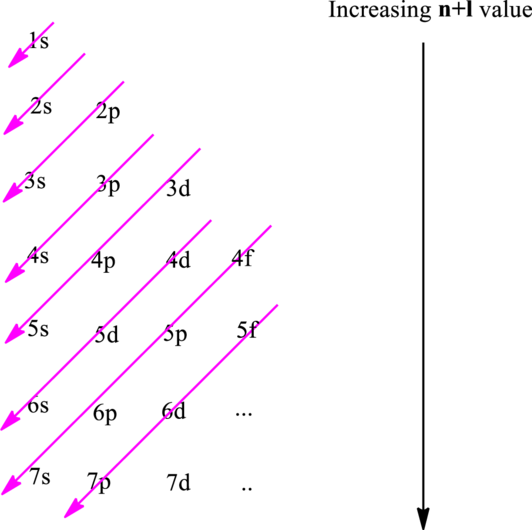
(a)
Interpretation:
The ground-state electronic configuration of
Concept Introduction:
The fundamental principles that are followed to write an electronic configuration include three rules as follows:
Electron in a

Hund’s rule suggests electrons are not allowed to be paired up until each degenerate set of orbital has got at least one electron.
Pauli Exclusion Principle states two electrons within the same orbital cannot possess same set for four possible quantum numbers.
In
(b)
Interpretation:
The ground-state electronic configuration of
Concept Introduction:
Refer to part (a).
(c)
Interpretation:
The ground-state electronic configuration of
Concept Introduction:
Refer to part (a).
(d)
Interpretation:
The ground-state electronic configuration of
Concept Introduction:
Refer to part (a).
Want to see the full answer?
Check out a sample textbook solution
Chapter 2 Solutions
Chemical Principles: The Quest for Insight
- What is the resonance form that describes the distribution of electrons in SeO2 ?arrow_forwardDescribe the structure of a P2 molecule in valence-bond terms. Why is P4 a more stable form of molecular phosphorus than P2?arrow_forwardSelenium tetrafluoride, SeF₄, is a colorless liquid that is used as a fluorinating reagent in organic synthesis. Based on your Lewis structure for SeF₄, how many electron domains are on the central atom?arrow_forward
- Write the ground-state electron configuration of O2 and calculate the bond order.arrow_forwardhow would I identify which of these Lewis structures (A, B, C or D) is correct for PO33- and what is the VSEPR shape of the compound?arrow_forwardDetermine the number of valence electrons in sulfuric acid (H₂SO₄) and then draw the corresponding Lewis structure (with minimized formal charges).arrow_forward
- Draw the Lewis structures of cyanate (OCN-) and fulminate (CNO-) ions and calculate their formal charges. Discuss their stability by giving resonance structures.arrow_forwardAccount for ALL the electron pairs and describe the shape around the central atom in XeF4.arrow_forwardThe cations O2+ and N2+ are formed when molecules of O2 and N2 are subjected to intense, high-energy solar radiation in Earths upper atmosphere. Write the electron configuration for O2+. Predict its bond order and magnetic behavior.arrow_forward
- Give two requirements that should be satisfied for a molecule to be polar. Explain why CF4 and XeF4 are nonpolar compounds (have no net dipole moments) while SF4 is polar (has a net dipole moment). Is CO2 polar? What about COS? Explain.arrow_forwardWhich has the greater bond lengths: NO2 or NO3? Explain.arrow_forwardSeveral Lewis structures can be written for perbromate ion, , the central Br with all single Br—O bonds, or with one, two, or three Br=O double bonds. Draw the Lewis structures of these possible resonance structures, and use formal charges to predict which makes the greatest contribution to the resonance hybrid.arrow_forward
 Chemistry: Principles and PracticeChemistryISBN:9780534420123Author:Daniel L. Reger, Scott R. Goode, David W. Ball, Edward MercerPublisher:Cengage Learning
Chemistry: Principles and PracticeChemistryISBN:9780534420123Author:Daniel L. Reger, Scott R. Goode, David W. Ball, Edward MercerPublisher:Cengage Learning ChemistryChemistryISBN:9781305957404Author:Steven S. Zumdahl, Susan A. Zumdahl, Donald J. DeCostePublisher:Cengage Learning
ChemistryChemistryISBN:9781305957404Author:Steven S. Zumdahl, Susan A. Zumdahl, Donald J. DeCostePublisher:Cengage Learning
 Chemistry & Chemical ReactivityChemistryISBN:9781337399074Author:John C. Kotz, Paul M. Treichel, John Townsend, David TreichelPublisher:Cengage Learning
Chemistry & Chemical ReactivityChemistryISBN:9781337399074Author:John C. Kotz, Paul M. Treichel, John Townsend, David TreichelPublisher:Cengage Learning Chemistry: The Molecular ScienceChemistryISBN:9781285199047Author:John W. Moore, Conrad L. StanitskiPublisher:Cengage Learning
Chemistry: The Molecular ScienceChemistryISBN:9781285199047Author:John W. Moore, Conrad L. StanitskiPublisher:Cengage Learning Chemistry: Principles and ReactionsChemistryISBN:9781305079373Author:William L. Masterton, Cecile N. HurleyPublisher:Cengage Learning
Chemistry: Principles and ReactionsChemistryISBN:9781305079373Author:William L. Masterton, Cecile N. HurleyPublisher:Cengage Learning





